TRIP REPORT: DRY TORTUGAS & SOUTH FLORIDA – 2017 April
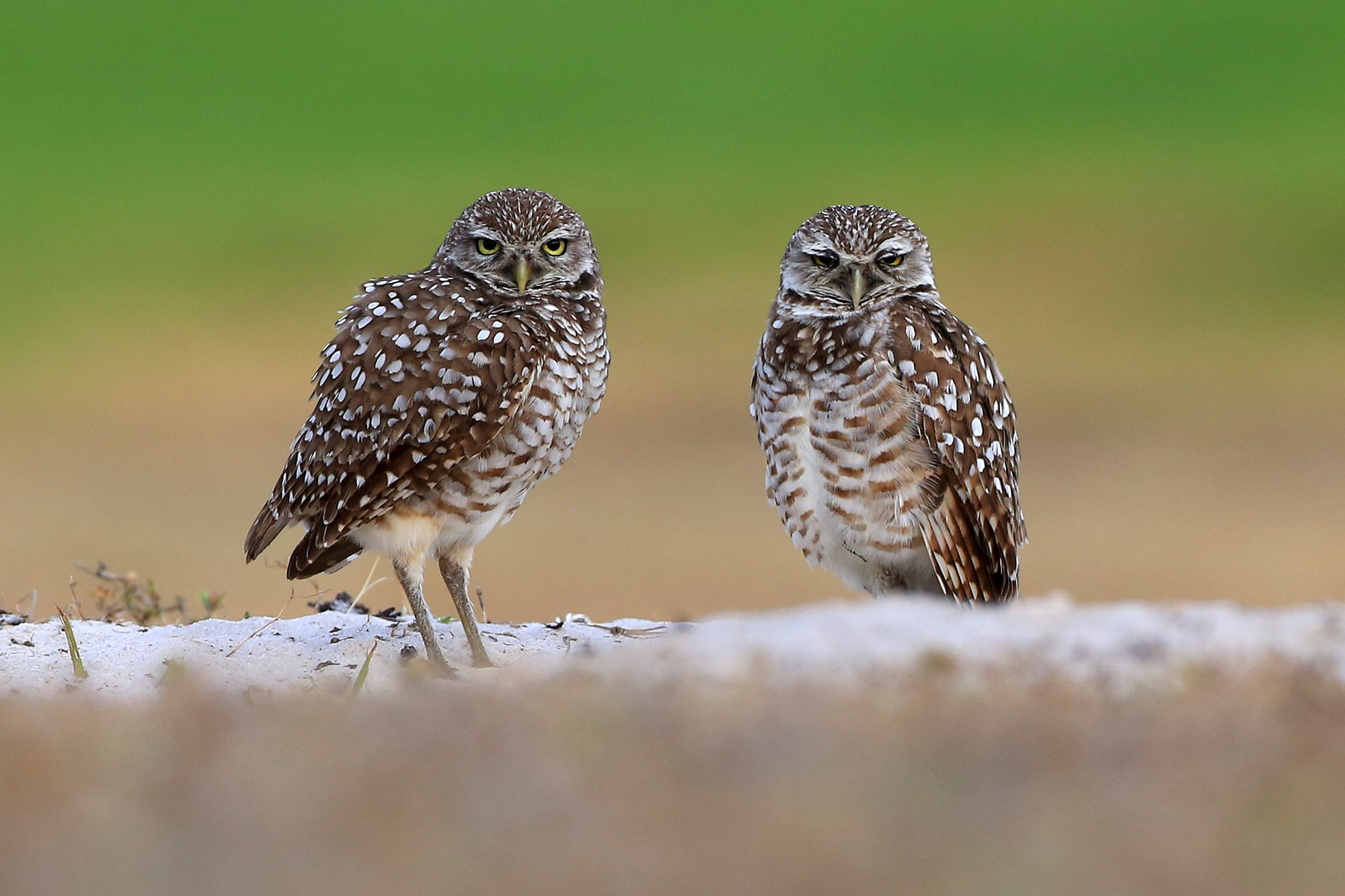
TOUR FOCUS
TRIP LEADERS
PRIVATE TOUR OPTION
This tour is available as a private trip for any size group. The tour cost will vary with the number of people and any custom requests.
TESTIMONIALS
Trip Report written by Adrian Binns
Day 1 / April 20 – Miami to West Palm Beach

Burrowing Owls
It was a wonderful start to our 10-day South Florida trip with great comparison of two similar parakeets perched in Canary Island Palms, White-winged and Yellow-chevroned, once lumped as Canary-winged. Continuing north we enjoyed Burrowing Owls in a brief rain shower, with one of them having its wings spread to catch the rain drops.
Much of the afternoon was spent at two wonderful man-made wetlands, Wakodahatchee and Green Cay, where we enjoyed the ongoing spectacle of nesting wading birds at the former, many so close! The Wood Stork numbers have increases dramatically in recent years and many were attending to several chicks pulling, with some still arguing over over sticks that were used as nesting material. Fluffy white Anhinga chicks rested with their heads draped over the edge of their nests. With their short patterned bills young Glossy Ibis would have been harder to identify if they were not in the presence of their parents. Great Blue and Tri-colored Herons, Cattle and Great Egrets also made up the colonies. The introduced Purple Swamphens could be seen using their toes to hold a bulrush stalk to feed on and Purple Gallinules walking along Fireflag stems to reach the flowers at near the tip.

Least Bittern
At Green Cay we added an Eastern Screech Owl peering out of its nest hole in a Cabbage Palm and an extraordinary time watching a stalking and successful strike by a Least Bittern. Other species encountered included Mottled Duck, Black-necked Stilt, Blue-winged Teal and Purple Martins.
Along a canal we found a Limpkin family with three chicks, and while going ‘house to house’ looking for Nanday Parakeets and Spot-breasted Orioles, we only came up with Monk Parakeets!
Day 2 / April 21 – Dupuis WMA; Lake Marion; Lake Kissimee; Lake Wales Ridge

Red-cockaded Woodpecker
Arriving at Dupuis soon after sunrise we were surprised not to find any Red-cockaded Woodpeckers at our first sight but quickly located a couple of them at the nest. They spent most of their time within view of their nest hole, an artificial box in a slash pine whose entrance hole was surrounded by pine sap to protect it from snakes. Our views of the birds were stellar. While watching them we could hear Northern Bobwhite, Pine Warbler, Carolina Wren and our other target, Bachman’s Sparrow who showed very well amongst the low saw palmettos.
Heading towards the multitude of lakes that are found in the south central part of the state, we stopped along the way to view Loggerhead Shrikes and Eastern Meadowlarks. At Lake Marian we enjoyed a pleasant picnic lunch while being serenaded by singing White-eyed Vireo and Northern Parula. Along the edge of the lake we scoped loafing Caspian, Gull-billed and Forster’s Tern as well as seven Long-billed Dowitchers, and a Limpkin could be seen wandering about.
Lake Kissimmee and it environs was full of life. A Crested Caracara flew across short prairie towards us as we approached the landing. Sandhill Cranes fed close to the marsh while a Snail Kite was quartering the marsh, and seen dropping in to pick off an apple snail. A pair of Limpkins were feeding their young apple snails and Bald Eagles majestically patrolled the skies.
The day ended with a marvelous encounter with a calling Barred Owl. the setting could not have been more perfect amongst stately Spanish moss covered Live Oaks!

Barred Owl
Day 3 / April 22 – South-Central Florida; Loxahatchee NWR; Cutler Wetlands

Florida Scrub Jay
We began the day in the company of Florida’s only endemic bird, the Florida Scrub Jay! Four individuals were content flying back and forth picking up peanuts and storing them in the sandy soil within the dense oak scrub. While watching these social jays a Northern Parula alighted in front of us and the Florida ‘white-eyed’ race of Eastern Towhee showed well.
A short distance away the Pinewoods held Downy, Red-bellied and a pair of Red-headed Woodpecker. We also got to see a pair of Great Crested Flycatcher tending to their nest cavity with one of them carrying nesting material in its mouth.
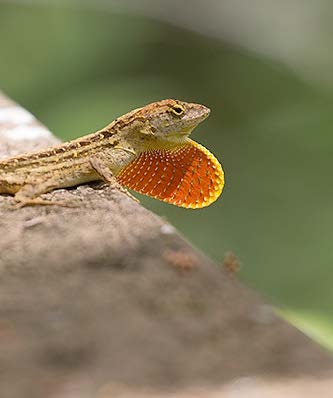
Brown Anole
In spite of Loxahatchee National Wildlife Refuge being rather quiet we enjoyed a walk through the Cypress Boardwalk where a red morph Eastern Screech Owl peered down on us from a woodpecker cavity. Speaking of woodpeckers, our other sighting was of a Pileated Woodpecker banging away at bark! A Brown Anole exposed its red-orange dewlap in the hopes of attracting a female oblivious to our presence inches away, and there were several Ruddy Daggerwings flittering about. Our first dragonfly of the day was the large Blue-faced Darner that was perfectly camouflaged hanging upside down in the shadows of narrow branches.
Walking the Marsh Trail birds were few and far between giving us a chance to enjoy Northern Curly-tailed Lizard, both juvenile (black and yellow) and adult (orange) Lubber Grasshoppers, Gulf Fritillaries and common dragons such as Four-spotted and Halloween Pennant, Eastern Pondhawk and Blue Dashers.
By late afternoon we were south of Miami watching a multitude of White Ibis bathing at Cutler Wetlands where Black-necked Stilts were seen pairing up.
Day 4 / April 23 – The Keys
Overnight rain gave way to overcast skies at day break that gradually cleared the further west we went along the Keys. Our first stop at Dagny Johnson on Key Largo was in the hopes to getting a Mangrove Cuckoo. No cuckoo but we did have White-eyed Vireos and our first Cape May Warblers.

Western Spindalis
Two vagrants, Western Spindalis and Bahama Mockingbird, had been at Windley Key Fossil State Park for the passed couple of days, and we managed to see both within an hour of our arrival. While both showed well, the spindalis (black-backed race) was seen several times in multiple spots including chasing Cape May’s from a favourite fruiting tree. Other warblers seen included Prairie, Palm, Parula and Blackpoll. We also had our best views of a Black-whiskered Vireo and the first of many Gray Kingbird.
A little further down the Keys at Long Key State Park, we went in search of LaSagra’s Flycatcher that was reported as being briefly seen on each of the last two days. It continued to prove elusive, though we did get a Black-whiskered Vireo, heard an Eastern Wood Pewee, and unfortunately a late Swainson’s Warbler did not cooperate for everyone in the group.
On Grassy Key, one of the shallow impoundments held four Red-breasted Merganser, a Greater Yellowlegs and we watched two white morph Reddish Egret actively dance about as they stalked fish. At the Marathon Government Building a pair of Roseate Terns was roosting on the dock with multiple pairs of Least Terns. As we entered Big Pine Key Pauline quickly spotted a diminutive Key Deer browsing along the road. On Sugarloaf Key we found several cowbirds, one of which was a male Shiny displaying next to a male Brown-headed.

Black-throated Blue Warbler
Over the course of the remained of the afternoon we made three spots in Key West, the Botanical Gardens, Indigenous Park and Zachary Taylor State Park. Most of the locations had the same warbler species, Cape May, Palm, Prairie, Common Yellowthroat, Blackpoll, American Redstart, Northern Waterthrush, Ovenbird and Black-throated Blue, while the gardens also held a couple of Worm-eating. Additional species included a nice comparison of Great White Heron and Great Egret at Indigenous Park, while Zachary Taylor had a couple of Swainson’s Thrush.
We enjoyed a lovely dinner at the Hogfish Tavern, where the hogfish tacos are highly recommended, before joining the the remainder of the group at the marine to board the Playmate for the beginning of the Dry Tortugas portion of our tour. Steve and Rafael were on hand to give us our orientation, we all got to meet Sara our excellent cook.
Day 5 / April 24 – Key West to Dry Tortugas
At 5.30am Captain Joe set sail and finally after several weeks of blowing easterlies and rough seas we experienced a smoother ride to the Dry Tortugas on calmer 1-3 foot seas with a north westerly wind.
Following breakfast we were outside on the upper deck enjoying the warm weather and encountering our first seabirds, North Gannets. This gave us a chance to compare them in the book with Brown and Masked Booby which we would come across later. We did not encounter any sargassum weed until well into the trip and that was when we came across the first of several Audubon Shearwater and a pair of Bridled Terns. The latter showed well as they passed in front of the bow, while it wasn’t until our sixth shearwater that everyone got a satisfying look. A phalarope flew passed low over the water, undoubtedly a Red-necked. Flying Fish and several cooperative Atlantic Bottle-nosed Dolphin kept us entertained as they swam along side.

Masked Bobbies
At Tails’ End, the remains of the marker structure held three Brown Bobbies. We encountered a couple of light short rain showers before watching the Masked Booby colony on Hospital Key. We could count almost a hundred of them, and were lucky enough to have several pairs of Masked Bobbies in the water close to the boat.
The first of what would be many thousand Sooty Terns and Brown Noddies flew across the bow as we entered the harbour at Fort Jefferson on Garden Key. Our attention was drawn to the south coaling docks where dozens of Sandwich Terns and a few Royal Tern were resting.
Excited, we disembarked and began to cover the 11 acre island. From the campground, to the brick pile on the way to the north coaling dock, and the parade grounds inside the fort, we covered every sea grape, buttonwood and gumbo limbo.
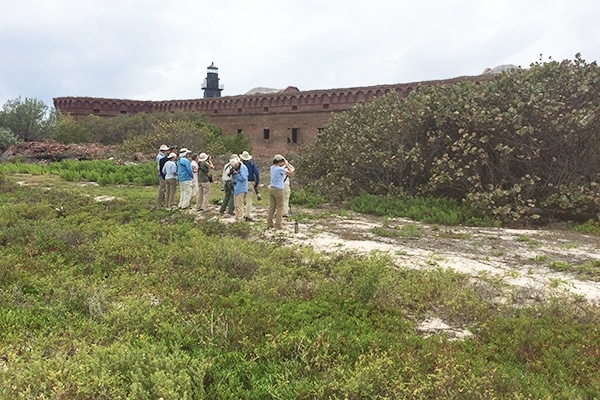
First up was a male Orchard Oriole chasing an immature male around a sea grape with a Cape May Warbler in hot pursuit. The importance of having a food source, in this case nectar from the flowers, being so vital to a bird on migration was very evident as they tried to chase each other away and even more so if it is limited. It is surprising that they had the energy given that they had just made a journey across the Gulf of Mexico!

Summer Tanager
It was obvious that Palm Warblers were ubiquitous and they wandered about the short grasses. American Redstarts and Ovenbird were numerous with several of the latter sighted in the campground. By the end of the day we had 15 species of warblers including one each of Northern Waterthrush, Prothonotary, Bay-breasted and Yellow.
After looking at Brown Noddies on the coaling dock we turned to concentrate on the activities along the brick pile. It was easy to pick out brilliant Scarlet and Summer Tanagers! A Yellow-billed Cuckoo posed for us as a Northern Parula walked amongst the ground cover. This was followed by a Dickcissel!
The parade ground was full on Indigo Buntings, along with a few Blue Grosbeaks and Rose-breasted Grosbeaks. Any cowbird is likely to be a Shiny, and a female gave us the opportunity to work on our identification. Terrorizing the passerines were three Merlins zipping around and over the buttonwoods along with two Peregrines. A pleasant surprise was a Sora in a buttonwood by the fountain! We covered the primary colours – red, blue and yellow, when found a male Painted Bunting.
Day 6 / April 25 – Dry Tortugas
After almost 3 weeks of howling winds, the winds finally abated and we had a very pleasant light northerly along with noticeably calmer seas.

Roseate and Common Terns
The day was spent on Garden Key where amongst the new overnight arrivals were Cave and Tree Swallows, Bobolink, a Western Kingbird and two Ruby-crowned Kinglets, the latter only have been recorded a few times on the islands. While looking for the lone Black Noddy amongst the hundreds, thousands of Brown Noddies on Bush Key and at the North Coaling Dock we found a Bridled Tern sitting on the edge of the concrete pad near the latter. Certainly an uncommon sighting on the islands!
There would be more tern species especially on the South Coaling Docks where dozens of Sandwich Terns were roosting. Amongst them two adult and immature Roseate Terns and an immature Common Tern, with Chris pointing out to us the finer points of identification between them (pictured above).
A nighthawk species, Common or Antillean was found, but separating these two similar species without them calling is a tough call. There would wonderful views of three vireos, White-eyed, Red-eyed and Black-whiskered. Yellow-billed Cuckoos were more visible today with as many as three in a tree. It was nice to see the rare orange morph of Scarlet Tanager (pictured below), especially when it was next to the regular one! Eastern Kingbirds and Gray Kingbirds were numerous, and as is often the case when there are many passerines about, there are raptors! A Sharp-shinned and Cooper’s Hawk, an American Kestrel, a couple of Merlins and Peregrines flew in and out of the fort. Cattle Egrets stalk the parade grounds in search of insects, but occasionally they get desperate and find a weak small bird and in this case it was an Indigo Bunting, that we watched it try and swallow. To our tally of warblers we added Worm-eating giving us 16 species.

Orange morph of Scarlet Tanager
It has often been proved to be true, that if one sits all day at the fountain every bird will show up. For several hours most of sat memorized at the endless stream of passerines popping into the fountain and surrounding buttonwood trees. At one stage we had Dickcissel, Scarlet Tanager, Rose-breasted Grosbeak, Indigo Bunting, Painted Bunting and Cape May Warbler all at once. Could it have been any more colourful!
A 7 foot Cuban Crocodile drew a lot of attention and showed well in the moat loafing at the surface!
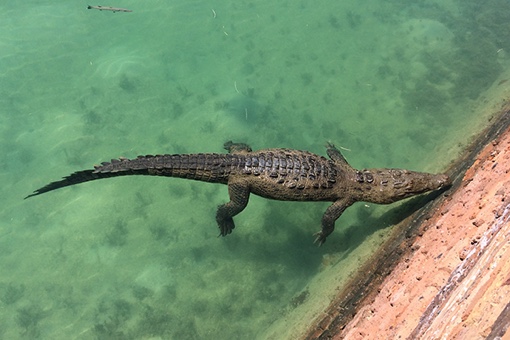
Cuban Crocodile
In the gorgeous late afternoon light we made four skiff runs to the frigate colony giving everyone a chance to see the terns flying close by us and getting near to the frigatebird colony. Ospreys and Brown Pelicans circled around with the latter diving for fish. An adult Brown Booby standing along the edge was a nice surprise with it taking to the air on one occasion. On one of the runs we had a handful of smaller waders, these being Least and Semipalmated Sandpiper, Sanderling, Semipalmated Plover and Black-bellied Plover. There were a few Peregrines about and it was likely one of them that scared the waders away. It was interesting to watch a Peregrine being chased by a brave Sooty Tern. Amongst the frigatebird colony there were several fluffy young chicks, and a couple of males sitting on their flimsy stick nests with their inflated red throat very visible.
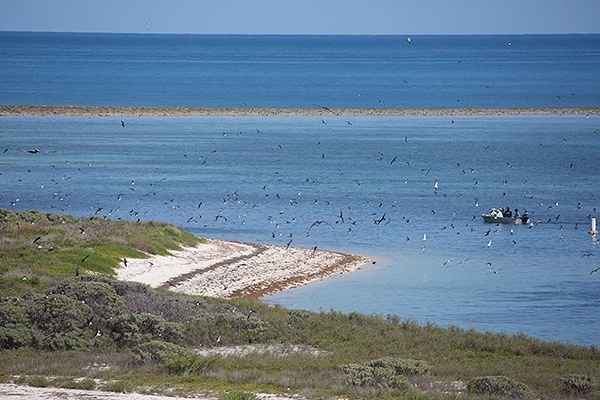
Day 7 / April 26 – Dry Tortugas to Key West
We had an hour at first light wandering about Garden Key in search of anything new that might have dropped in overnight. Warbler numbers seem to be down with the exception of a few new Yellow Warblers, maybe some had taken off, or possibly it was because we did not have longer to find them. For those that had missed them yesterday, they caught up with Ruby-crowned Kinglet, Bobolink and Western Kingbird. A nighthawk perched in the buttonwood was more than likely a Common.
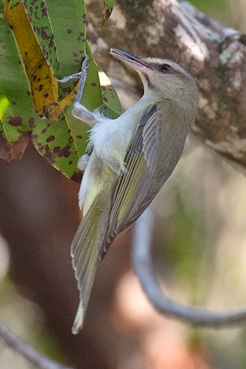
Black-whiskered Vireo
The seas were relatively calm on the return journey to Key West, with a light easterly headwind. At Rebecca, three Brown Bobbies were on the marker. Later we would have a Pomarine Jaeger cross the bow, and Loggerhead Turtles and Atlantic Bottle-nosed Dolphin were spotted close to the boat. Eleven Roseate Terns on Marker 8 off of Key West wrapped up our wonderful trip to the Dry Tortugas. We finished with a total of 93 species which is outstanding and even more surprising given that there was only 16 warbler species recorded.
Heading back up the Keys we stopped at No Name Key where a number of diminutive Key Deer ambled about various yards and along the road. Black-whiskered and White-eyed Vireo showed well. Following a delicious dinner at 7-Mile Grille in the company of a moon-walking Common Myna we proceeded to Marathon Airport where we soon located a nighthawk flying over the distant hardwoods. It proceeded westwards, and we followed! Deidra, Lisa and Becky, where in the right place and we all got to see and hear the calling Antillean Nighthawk.
Day 8 / April 27 – Everglades National Park

Mangrove Cuckoos
Before daybreak from outside our hotel room we could hear both Common Nighthawk and Chucks-will-widow calling. An early start and some patience was well rewarded with calling Mangrove Cuckoos. There were five birds, with one pair putting on a tremendous show for us, witnessing extraordinary behaviour mostly at eye level! They worked their way slowly along the edge of the mangroves, with the male occasionally calling softly and the female following behind. The male found a caterpillar, which got the female all excited. She began to pump her tail and he flew up and mounted her, presenting her with the caterpillar. A few minutes later the process was repeated this time with a stick insect! Then again, with an orb spider!
The sign at the entrance to the Everglades National Park said, Mosquitos High! With the end of spring upon us and the onset of the summer rains not to far away, the mosquitos were already here, though maybe not as bad as anticipated away from the hardwoods. The Anhinga Trail at Royal Palm was quiet with the exception of alligators and a few Anhingas. Dragonflies included Needhams’ Skimmer and the ubiquitous Blue Dasher.

Lionfish
At Flamingo the quickly rising tide meant that the only birds remaining on the sand bar where Osprey and Brown Pelicans. Nearby we could see Caspian Tern, American White Pelicans, Great White Herons, Snowy and Great Egrets. A few Swallow-tailed Kites graced the tree tops. The American Crocodiles were at Marina as was a large Lionfish, the bane of local waters! A nice variety of shorebirds were along the campground shoreline including Western Willet, Ruddy Turnstone, Spotted Sandpiper, Semipalmated Sandpiper and a Wilson’s Plover.
It is a shame that EcoPond is no longer the vibrant and bustling stop it once was. A preening Red-shouldered Hawk and begging juvenile Osprey were in the surrounding trees, while a few Black-necked Stilts stood in the shallow off-coloured water and the remains of a drone could be seen exposed in the mud!
The rookery at Paurotis Pond was alive with the sound of young waders begging. A cluster of Roseate Spoonbills could be seen at the far end along with a few Wood Storks flying over. On Long Pine Key we quickly found several Pine Warblers, a Brown-headed Nuthatch and watched a Common Nighthawk drinking from the lake.
After stopping at Robert is Here for their obligatory milk shakes, we ended the afternoon watching a dozen or more Caribbean Cave Swallows flying around the 217th Street turnpike bridge, as well as going in and out of their mud nests.
Day 9 / April 28 – South Miami; Crandon Park

Chestnut-fronted Macaw
The morning began in the Kendall neighbourhood going house-to-house, wire-to-wire (but not for long) before Chris spotted a pair of Red-whiskered Bulbuls.
The tantalizing allure of four Bahamian and Caribbean birds; Western Spindalis, Bahama Mockingbird, Bananaquit and Thick-billed Vireo, along with a South American vagrant Fork-tailed Flycatcher all in the same vicinity, Crandon Park on Key Biscayne, was extraordinary, and our next destination. This was indeed an unprecedented spring for rarities in Southern Florida!
Two of these birds we had not seen, Thick-billed Vireo and Bananaquit, and they happened to be the two that had already been seen by the time we arrived. A multitude of birders were lined along the Osprey Beach Trail with a line drawn in the sandy path marking where the vireo had been seen. The Bananaquit was showing sporadically around several flowering coral beans near the nature center. On the whole the area was quite and mostly devoid of migrants with the exception of a few Cape Mays. When we got word the bananaquit showed, it was always very briefly and we happened to be in the wrong spot! After a while most opted to try the Gardens at the South section of the park, with Teri and Chris staying behind. Egyptian Geese roamed the Gardens as if they owned the place, Gray Kingbirds were constantly in motion perching briefly before flying to another perch and a pair of Sandhill Cranes wandered about with their chick. Back at the North section, Chris was in the right place at the right time and saw the vireo.

Egyptian Goose
We enjoyed a wonderful trip, finding 188 bird species (5 being non-ABA countable) in various sub-tropical habitats. In addition to bonus rarities – Bahama Mockingbird, Western Spindalis and Thick-billed Vireo – highlights included: Burrowing Owls catching the rain with outstretched wings; the cacophony of numerous wader chicks begging at Wakodahatchee; a Snail Kite quartering in front of us, then dropping down to pick up an apple snail and eat it; Red-cockaded Woodpeckers cavorting around their nest site; Florida Scrub Jays making sortees to store food; side-by-side comparisons of White-winged and Yellow-chevroned Parakeet; Antillean Nighthawk calling over our heads; and mating Mangrove Cuckoos!
On the Dry Tortugas, the seabird spectacle is magical amid a stunning setting. Thousands of Sooty Terns, Brown Noddys, and Magnificent Frigatebirds soared, dove, and jostled for preening space on the coaling docks, in a non-stop wave of sound and activity. We recorded a phenomenal 93 species, of which ‘only’ 16 were warblers! The island’s freshwater fountain hosted an extraordinary diversity of tanagers, kingbirds, cuckoos, buntings, dickcissels, and warblers. A lovely surprise, the orange morph of Scarlet Tanager, added to the kaleidoscope of colour that flitted around the main attraction.
© adrian binns / WildsideNatureTours.com




